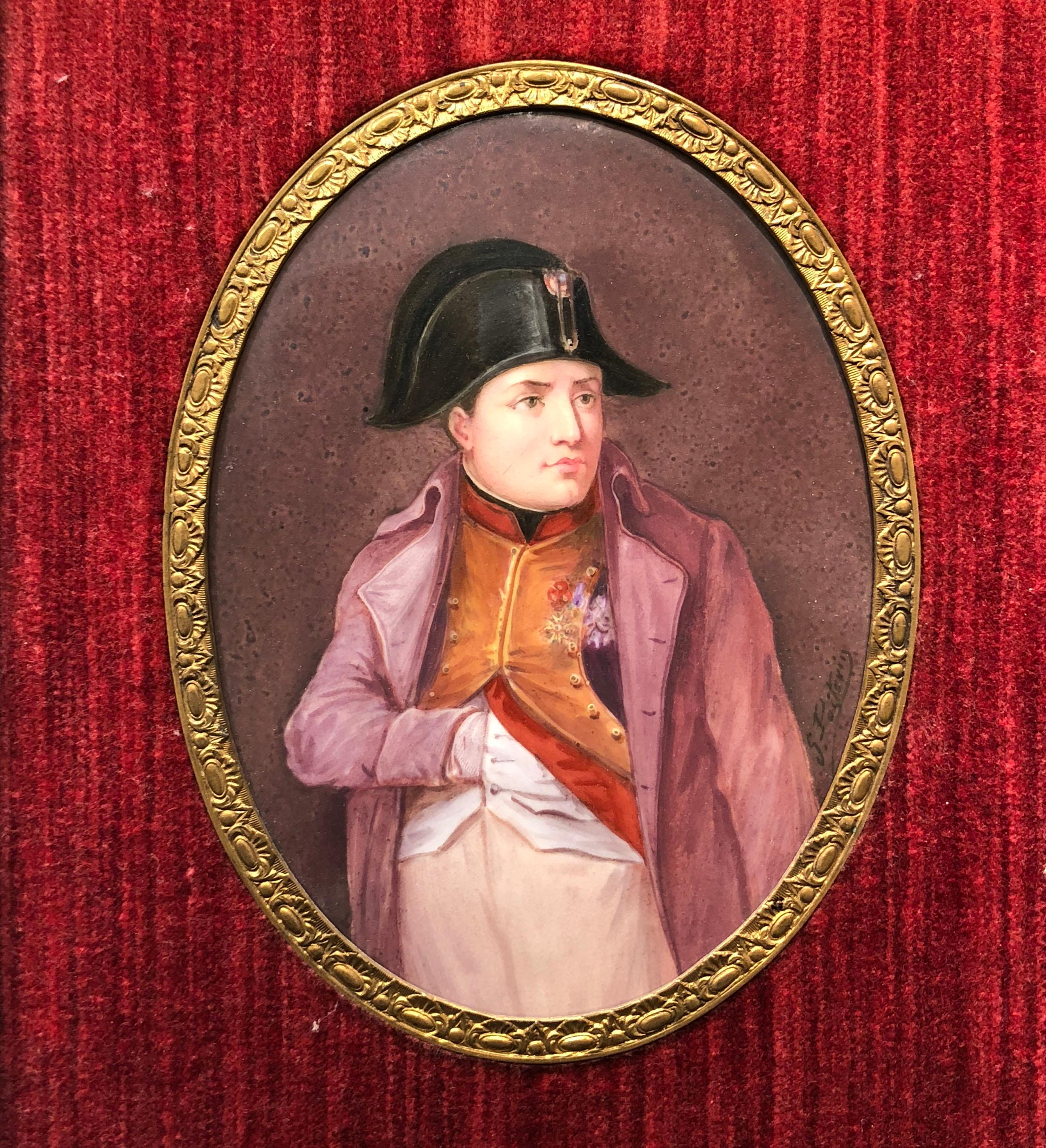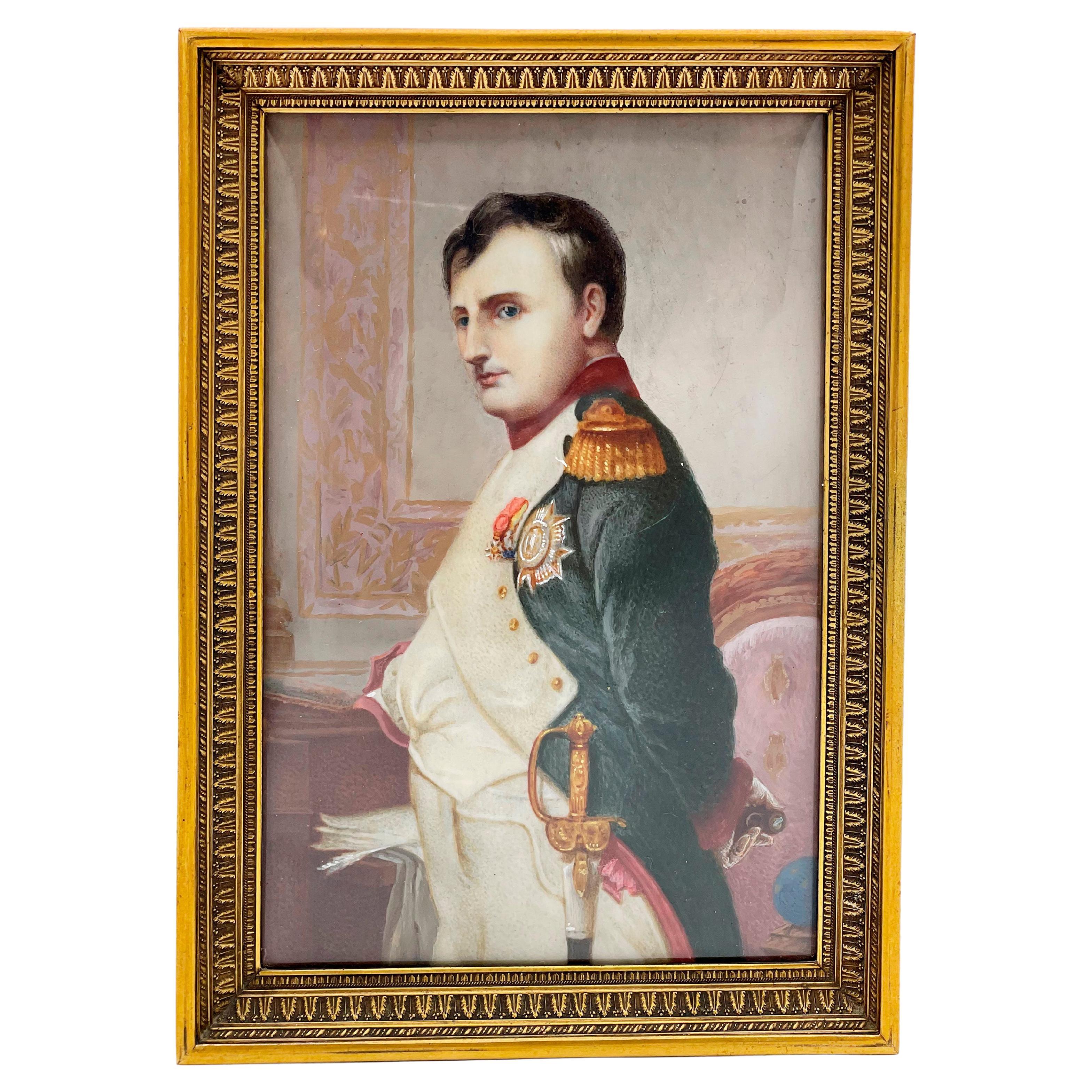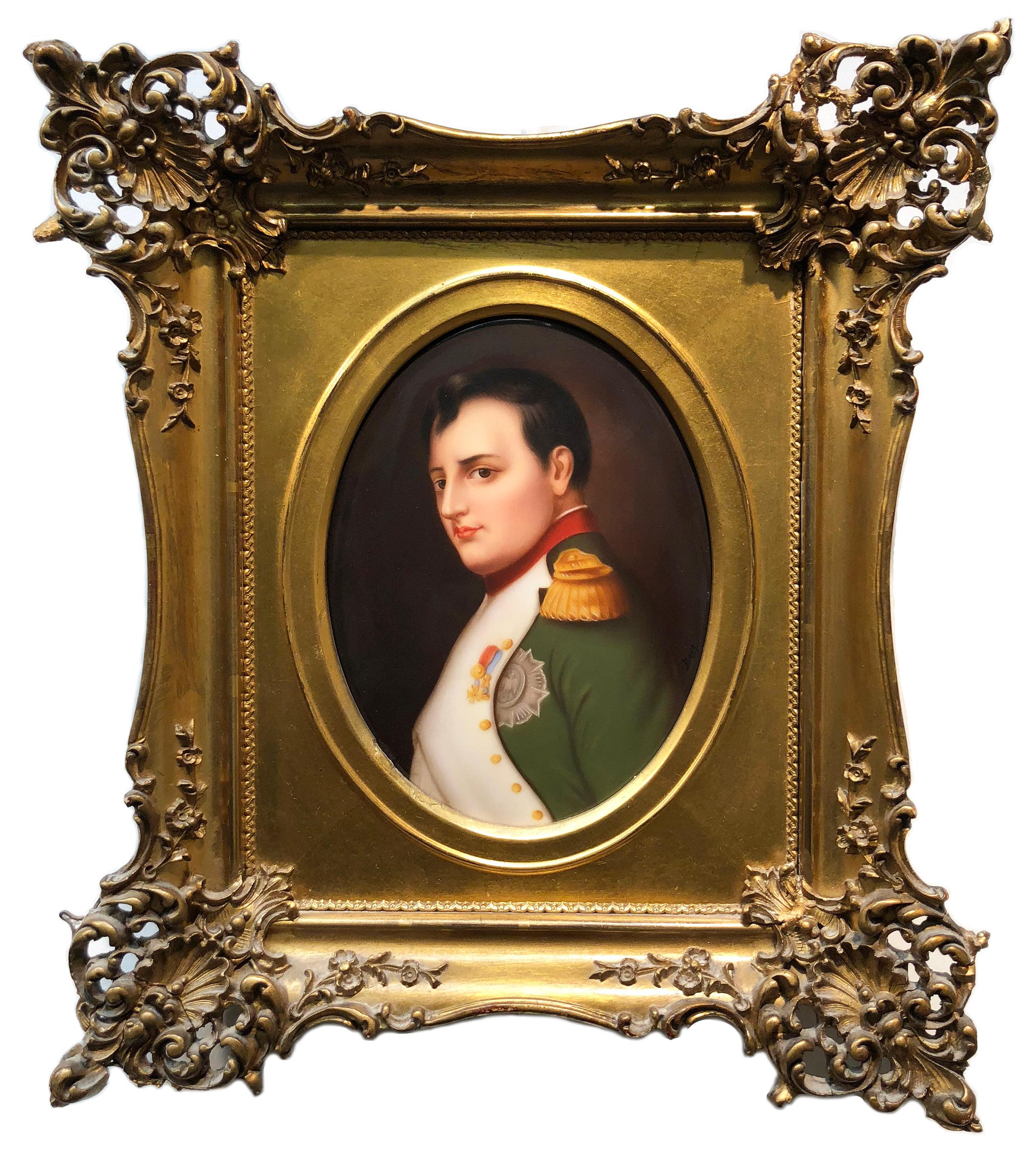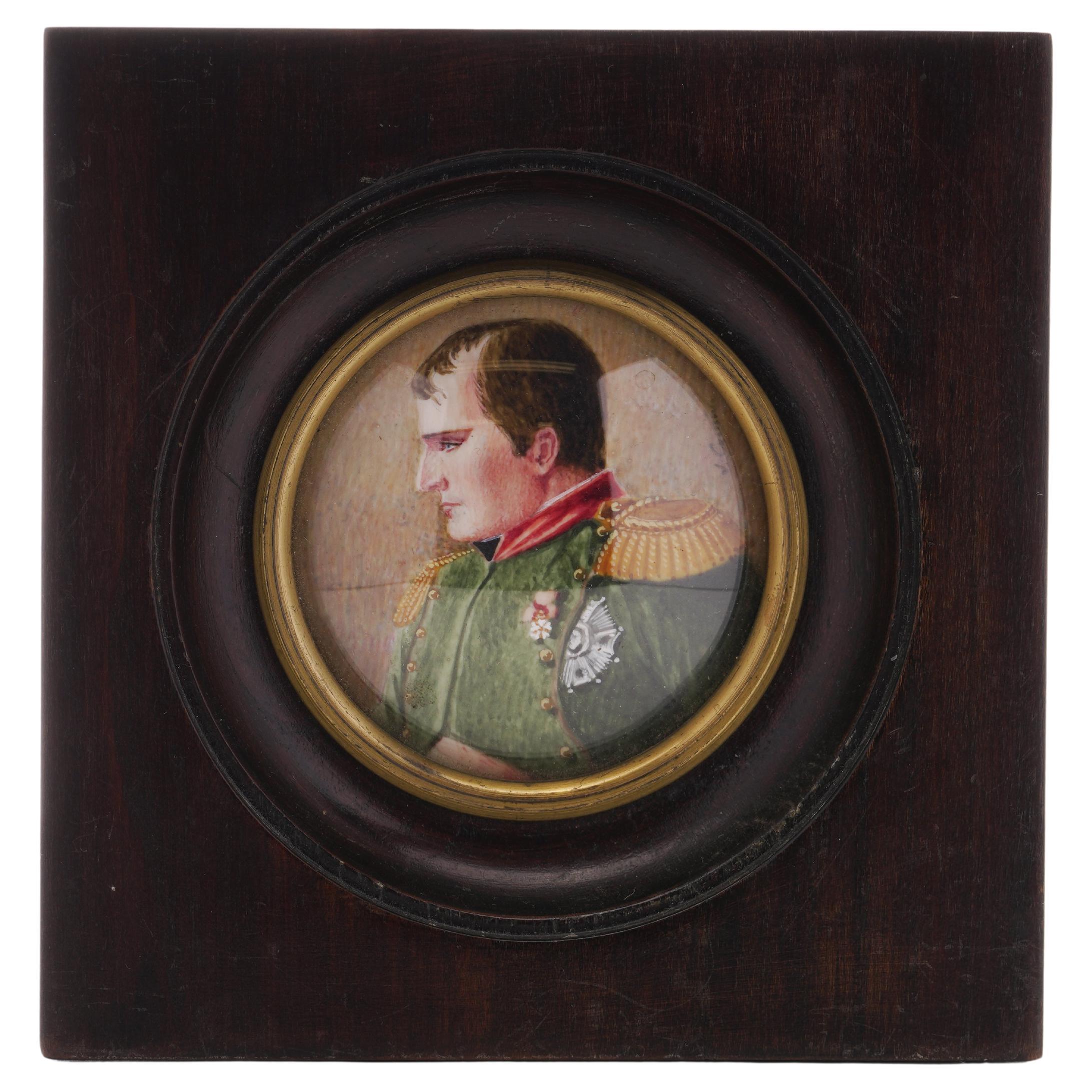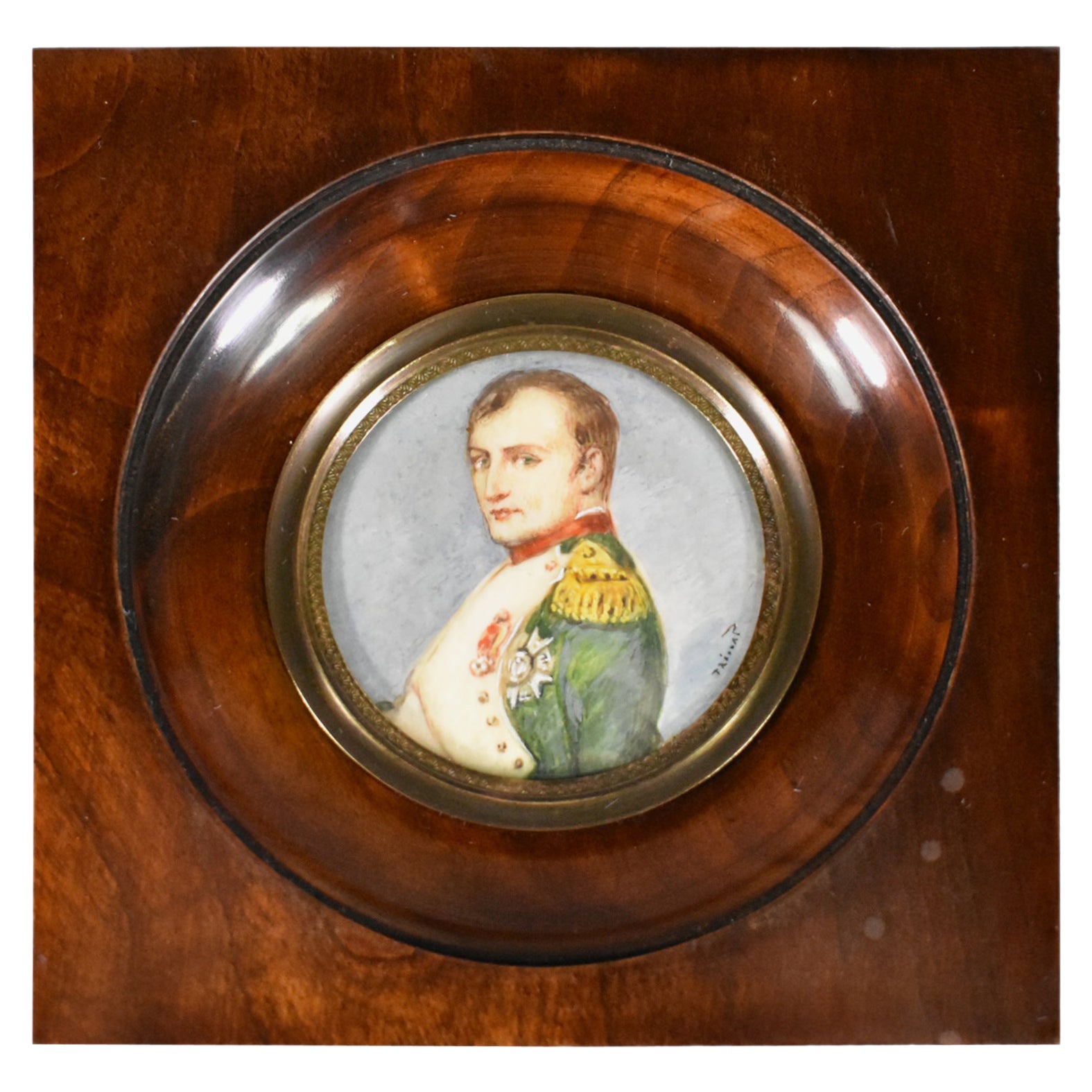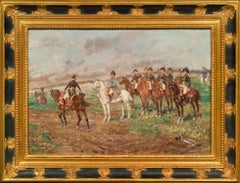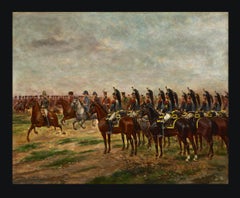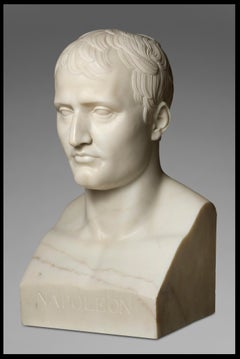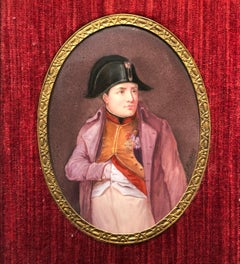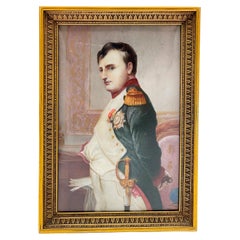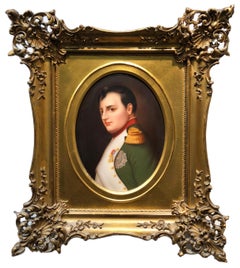Items Similar to MINIATURE - L'Empereur Napoleon Ier
Want more images or videos?
Request additional images or videos from the seller
1 of 3
Jacques LienardMINIATURE - L'Empereur Napoleon Ier19th Century
19th Century
$33,383.99
£24,732.53
€28,000
CA$45,734.39
A$50,746.16
CHF 26,581.93
MX$622,284.18
NOK 338,113.01
SEK 319,164.26
DKK 212,989.83
Shipping
Retrieving quote...The 1stDibs Promise:
Authenticity Guarantee,
Money-Back Guarantee,
24-Hour Cancellation
About the Item
Jacques Lienard
(1779-1848) French
Napoleon Ist
Miniature on Porcelain
Signed
Porcelain: 5 1/2 high x 4 1/5 wide
- Creator:Jacques Lienard (1779 - 1848, French)
- Creation Year:19th Century
- Dimensions:Height: 5.24 in (13.3 cm)Width: 4.14 in (10.5 cm)Depth: 1.19 in (3 cm)
- Medium:
- Movement & Style:
- Period:
- Condition:
- Gallery Location:Paris, FR
- Reference Number:Seller: 51881stDibs: LU68732123643
About the Seller
5.0
Recognized Seller
These prestigious sellers are industry leaders and represent the highest echelon for item quality and design.
Established in 1969
1stDibs seller since 2017
18 sales on 1stDibs
Typical response time: 1 to 2 days
- ShippingRetrieving quote...Shipping from: Paris, France
- Return Policy
Authenticity Guarantee
In the unlikely event there’s an issue with an item’s authenticity, contact us within 1 year for a full refund. DetailsMoney-Back Guarantee
If your item is not as described, is damaged in transit, or does not arrive, contact us within 7 days for a full refund. Details24-Hour Cancellation
You have a 24-hour grace period in which to reconsider your purchase, with no questions asked.Vetted Professional Sellers
Our world-class sellers must adhere to strict standards for service and quality, maintaining the integrity of our listings.Price-Match Guarantee
If you find that a seller listed the same item for a lower price elsewhere, we’ll match it.Trusted Global Delivery
Our best-in-class carrier network provides specialized shipping options worldwide, including custom delivery.More From This Seller
View AllLes Chasseurs de la Garde Impériale saluent l'Empereur Napoléon 1er et son Etat
By Paul Emile Léon Perboyre
Located in Paris, FR
Paul Emile Perboyre
1826-1914 French
Le Marechal Ney passant ses Troupes en Revue (The Marshall Ney reviewing his Troops)
Oil on mahogany panel
Signed l...
Category
19th Century Figurative Paintings
Materials
Oil, Panel
Napoléon and his Marshals
By Emile Chepfer
Located in Paris, FR
Emile Chepfer,
1876-1944, French
Napoléon and his Marshals,
Signed lower left
Oil on board
Emile CHEPFER: french painter, he was born in Nancy in 1876...
Category
20th Century Academic Figurative Paintings
Materials
Canvas, Oil
Le Marechal Ney passant ses Troupes en Revue
By Paul Emile Léon Perboyre
Located in Paris, FR
Paul Emile Perboyre
1826-1914 French
Le Marechal Ney passant ses Troupes en Revue (The Marshall Ney reviewing his Troops)
Oil on panel
Signed lower righ...
Category
19th Century Old Masters Figurative Paintings
Materials
Canvas, Oil
Napoleon Ist
Located in Paris, FR
Antoine-Denis CHAUDET (1763 - 1810)
NAPOLEON Ist, circa 1808
Carrare Marble - First Empire
Hermes Bust of Napoleon Ist, after Antoine-Denis CHAUDET
Dimen...
Category
Early 1800s French School Figurative Sculptures
Materials
Marble
$77,498
Vive l'Empereur
By Charles Edouard Richefeu
Located in Paris, FR
Charles Edouard Richefeu
1868-1945 French
Vive l'Empereur
Bronze, Susse Fondeur in Paris
Signed on the base, on the right side
39 1/2" high and approximatively 21 1/4" wide x 21...
Category
Late 19th Century Figurative Sculptures
Materials
Bronze
Revue à Longchamp
By Paul Emile Léon Perboyre
Located in Paris, FR
Paul Emile Perboyre
1826-1914 French
Revue à Longchamp,
Oil on panel
Signed lower right
Panel: 27 1/2" high x 45 1/4" wide
Fame: 40 1/8" high x 57 1/2" wide
Paul-Emile Léon PERBOYRE: painter of battles born in Horbourg near Colmar in 1826, died in 1907. Painter of history, battles.
He was a pupil of Leon Bonnat. He exhibited in Paris at the Salon of French Artists, in which one he became a member in 1909. He obtained an honorable mention in 1908.
Perboyre was well known for his many paintings of...
Category
19th Century Old Masters Figurative Paintings
Materials
Canvas, Oil
You May Also Like
Napoleon
By Manufacture Nationale de Sèvres
Located in Missouri, MO
Sevres 19th C.
Original Hand Painted Porcelain
Signed "G Poitevin"
approx 9 x 5 inches/15 x 12 framed
The vast and diverse production of the Sèvres factory in the nineteenth century resists easy characterization, and its history during this period reflects many of the changes affecting French society in the years between 1800 and 1900. Among the remarkable accomplishments of the factory was the ability to stay continuously in the forefront of European ceramic production despite the myriad changes in technology, taste, and patronage that occurred during this tumultuous century.
The factory, which had been founded in the town of Vincennes in 1740 and then reestablished in larger quarters at Sèvres in 1756, became the preeminent porcelain manufacturer in Europe in the second half of the eighteenth century. Louis XV had been an early investor in the fledgling ceramic enterprise and became its sole owner in 1759. However, due to the upheavals of the French Revolution, its financial position at the beginning of the nineteenth century was extremely precarious. No longer a royal enterprise, the factory also had lost much of its clientele, and its funding reflected the ruinous state of the French economy.
However, the appointment in 1800 of Alexandre Brongniart (1770–1847) as the administrator of the factory marked a profound shift in its fortunes. Trained as both an engineer and a scientist, Brongniart was both brilliant and immensely capable, and he brought all of his prodigious talents to the running of the troubled porcelain factory. He directed the Sèvres factory as administrator until his death in 1847, and during those five decades influenced every aspect of its organization and production. Much of the factory’s old, undecorated stock was immediately sold off, and new forms—largely in the fashionable, more severe Neoclassical style—were designed to replace out-of-date models. The composition for hard-paste porcelain was improved, and the production of soft paste, for which the factory had been famous in the previous century, was abandoned in 1804. New enamels colors were devised, and Brongniart oversaw the development of a new type of kiln that was both more efficient and cost-effective.
Much of the factory’s output during Brongniart’s first decade reflected the prevailing Empire taste, which favored extensive gilding, rich border designs, and elaborate figural scenes (56.29.1–.8). Backgrounds simulating marble or a variety of hardstones were employed with greater frequency (1987.224); the new range of enamel colors developed under Brongniart made it easier to achieve these imitation surfaces, and it is thought that his interest in mineralogy provided the impetus for this type of decoration.
For objects produced in sets, such as dinner, tea, and coffee services, and even garnitures of vases, Brongniart preferred decorative schemes that linked the objects in terms of subject matter as well as stylistically. Dinner services were given coherence by the use of an overall theme, in addition to shared border patterns and ground colors. One of the best examples of this can be found in the “Service des Départements,” which was conceived by Brongniart in 1824 (2002.57). Each of the plates in the service was decorated with a famous topographical view of the département (administrative unit) of France that it represented, and its border was painted with small cameo portraits of figures from the region, as well as symbols of the major arts, industries, and products of the area. This same type of thematic unity is found on a coffee service produced in 1836 (1986.281.1ab–4). All of the pieces of the service are decorated with scenes depicting the cultivation of cacao, from which chocolate is made, or various stages in the preparation of chocolate as a beverage. The compositions were conceived and executed by Jean Charles Develly, a painter at Sèvres who was responsible for many of the most ambitious dinner services produced at the factory during Brongniart’s tenure.
The range of objects produced in the first half of the nineteenth century was enormous, as were the types of decoration that they employed. A recent exhibition catalogue devoted to Brongniart’s years at Sèvres indicates that ninety-two new designs for vases were introduced, as were eighty-nine different cup models, and the types of objects produced by the factory included every sort of form required by a dinner or dessert service, coffee and tea wares, decorative objects such as vases, and functional objects such as water jugs, basins, and toiletry articles. A new form rarely replaced an older one; the range of production simply increased.
The same was true with types of decoration, as the factory was working in a wide variety of styles at any given time. From the earliest years of the Sèvres factory, its painters had copied not only contemporary compositions but also prints and paintings from earlier periods. However, under Brongniart, the factory sought to copy famous paintings with the specific intention of recording the “true” appearance of works increasingly perceived to be fragile. Works by a wide variety of artists were copied, but those by Raphael were especially popular. Raphael’s stature is reflected in a vase of 1834 in which a cameo-style portrait of the artist decorates the primary reserve, while on the back an artist’s palette is encircled by the names Titian, Poussin, and Rubens (1978.373).
Just as works by earlier artists were copied, so too were decorative techniques of previous centuries. The interlace patterns of so-called Saint-Porchaire ceramic ware of the sixteenth century served as the inspiration for the decoration on a cup of 1837 (2003.153). The form of the cup itself derives from Renaissance silver forms made in Italy and France. However, the palette of vibrant reds, greens, blues, and yellows contrasts markedly with the muted browns and off whites of Saint-Porchaire wares and reflects the reinterpretation of historical styles that was characteristic of so much of nineteenth-century decorative arts.
Interest in the Gothic style emerged early in Brongniart’s tenure at Sèvres and remained popular for much of the nineteenth century. Strict adherence to Gothic motifs was rarely observed, however, and the Gothic style was more evoked than faithfully copied. This tendency is reflected in a pair of vases (1992.23.1) for which the model was designated vase gothique Fragonard (named after the vase’s designer, Alexandre Evariste Fragonard [1780–1850]. The Gothic elements lie more in the painted decoration than in the form itself, and the style of the painting reflects a Renaissance technique rather than a medieval one. The palette of grays and whites on a blue ground instantly recalls the enamel-on-copper wares produced in Limoges, France, in the sixteenth century, and its use on these vases indicates the willingness to freely mix artistic styles and techniques of different periods in order to achieve new aesthetic effects.
The eclecticism and historicism that characterized so much of the production during Brongniart’s tenure continued after his death in 1847. The factory’s output reflected an ongoing desire for technical innovation as well as a wide embrace of diverse decorative styles that were employed simultaneously. A tea and coffee service of 1855–61 (69.193.1–.11) embodies the selective borrowing of forms and motifs that is found so frequently in Sèvres production of the middle decades of the nineteenth century. The shapes used for the different components of the service evoke both China and the Near East, an obvious allusion to the origins of the two beverages. The openwork decoration refers directly to Chinese ceramics made in this technique, and the decoration employs a variety of Chinese emblems. However, the palette of pink and gold, entirely European in character, serves to neutralize the Asian aspects of the service.
Perhaps the only thread that can be said to run through much Sèvres production of the nineteenth century is the proclivity to borrow freely from various historical styles and then to either reinterpret these styles or combine them in unprecedented ways. A standing cup of 1879 (1990.238a,b) draws upon silver cups of the Renaissance for its form, but in this instance the size of the porcelain cup dwarfs any of its metal prototypes. Its style of decoration derives from Limoges painted enamels of the sixteenth century, but the prominent use of gilding throughout reflects its wholly nineteenth-century character. This cup was presented by the French government to one of the first-prize winners at the 1878 Exposition Universelle.
It was with the advent of the Art Nouveau style at the very end of the nineteenth century that historicism lost its grip at Sèvres, and indeed throughout the decorative arts, and forms inspired by nature and often characterized by asymmetry become dominant. This reliance upon natural forms is fully evident in a coffee service of 1900–1904 (1988.287.1a,b). The designer, Léon Kann...
Category
Late 19th Century Figurative Paintings
Materials
Porcelain, Oil
Price Upon Request
Oil Painting Portrait Miniature: Napoleon Bonaparte, Full Military Dress
Located in Autonomous City Buenos Aires, CABA
Antique Oil Painting French Portrait Miniature: Napoleon Bonaparte, Full Military Dress
France, Mid-19th Century
Measures:
13 centimeters ...
Category
Antique Mid-19th Century French Neoclassical Paintings
Materials
Wood
Portrait of Colonel Charles-Louis-Prosper Marquis de Chérisey (1786-1837)
Located in Paris, IDF
After Louis-Stanislas MARIN-LAVIGNE (Paris, 1797 – Paris, 1860)
Portrait of Colonel Charles-Louis-Prosper Marquis de Chérisey (1786-1837)
in the uniform of commander of the 38th lin...
Category
Mid-19th Century French School Portrait Paintings
Materials
Oil
Napoleon
By Königliche Porzellan-Manufaktur (KPM)
Located in Missouri, MO
KPM Style German
"Napoleon" c. late 19th c.
Signed "Bock"
Original Hand-Painted Porcelain
Marked Verso
approx 7 x 5 inches/approx 10 x 8 framed
Category
Late 19th Century Realist Portrait Paintings
Materials
Porcelain, Oil
Price Upon Request
19th-century hand-painted watercolour miniature portrait of Napoleon I
Located in Braintree, GB
Antique 19th-century mahogany wood-framed hand-painted watercolour miniature portrait of Napoleon I.
The miniature depicts a Napoleon I...
Category
Antique 1830s European Paintings
Materials
Wood
Miniature Portrait Painting of Napoleon Signed by Prévost
By Prevost
Located in SAINTE-COLOMBE, FR
Miniature Portrait Painting of Napoleon signed by Prévost from the nineteenth century.
The frame is in solid mahogany and is dished and...
Category
Antique 19th Century French Empire Paintings
Materials
Brass
More Ways To Browse
Antique Portrait Miniature
Portrait On Porcelain
French Miniature Portraits
Portrait Miniatures France
Antique French Miniature Portrait
Antique Porcelain Miniatures
Napoleon Jacques
Napoleon Miniature Portrait
Painting Napoleon Miniature
Bernardino Campi
Damilola Ilori
Ecstasy Of Saint Teresa
Elisabeth Dujarric De La Riviere
Emile Vernon
Eustache Le Sueur
Gerard Van Honthorst
Hibel Oil
Italian Food Posters
